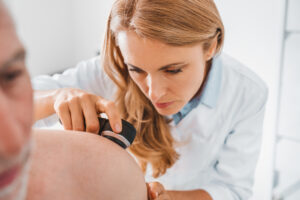 Acrochordons (acrochordons) are small, noncancerous growths that tend to match the color of your skin, and they are not dangerous. Often, they resemble a cluster of skin tissue extending from a small stem. They can be darker and resemble a raised mole in appearance. Skin tags typically range in size from 1 to 5 millimeters, but some can reach a length of several centimeters. Skin tags, which resemble warts, are small growths on the skin. A slender stalk connects them to the skin. When a person gets older, they’re more likely to develop skin tags. Skin tags are harmless, but if you are bothered by one, you should discuss having it removed with your doctor. They typically don’t exceed 2 millimeters in length, but they have the potential to do so. They have a supple texture and can be round, wrinkled, or even resemble a grain of rice in appearance. It’s possible to find them in a variety of shades of brown or even black. You should always see your doctor if you notice a new growth or spot on your skin. Find out if you should have your skin checked for cancer. Formed of collagen and blood vessels, skin tags are a common problem for many people. They can be found in the armpits, groin, thighs, eyelids, neck, or under the breasts, depending on where the skin folds.
Acrochordons (acrochordons) are small, noncancerous growths that tend to match the color of your skin, and they are not dangerous. Often, they resemble a cluster of skin tissue extending from a small stem. They can be darker and resemble a raised mole in appearance. Skin tags typically range in size from 1 to 5 millimeters, but some can reach a length of several centimeters. Skin tags, which resemble warts, are small growths on the skin. A slender stalk connects them to the skin. When a person gets older, they’re more likely to develop skin tags. Skin tags are harmless, but if you are bothered by one, you should discuss having it removed with your doctor. They typically don’t exceed 2 millimeters in length, but they have the potential to do so. They have a supple texture and can be round, wrinkled, or even resemble a grain of rice in appearance. It’s possible to find them in a variety of shades of brown or even black. You should always see your doctor if you notice a new growth or spot on your skin. Find out if you should have your skin checked for cancer. Formed of collagen and blood vessels, skin tags are a common problem for many people. They can be found in the armpits, groin, thighs, eyelids, neck, or under the breasts, depending on where the skin folds.
In most cases, skin tags are completely painless and have no noticeable effects on one’s health. Wearing jewelry or clothing can cause irritation, resulting in sores and bleeding. Since skin tags have a small stalk attached to them, they appear to be distinct from other benign skin lesions. Unlike warts, skin tags tend to protrude from the skin.
When there are extra cells in the upper layers of the skin, they form skin tags. People with folds of skin, such as those who are obese, are more likely to get them. They are more common in older adults and people with type 2 diabetes, and they affect both men and women. After the birth of a child, pregnant women are more likely to develop skin tags. Over time, skin tags may fall off on their own. To remove a skin tag, consult your doctor if it is bothering you or you don’t like the way it looks.
Skin tags can be removed by:
- freezing them with liquid nitrogen
- cutting them off with scissors or a scalpel
- burning them with electrical energy (cauterizing)
Attempting to remove skin tags on your own can be dangerous because they can bleed heavily or become infected. It is possible to remove a small skin tag at home by consulting with your doctor. Skin tag removal solutions can be purchased from a pharmacy or online in the same way as wart removal solutions. There is a slew of natural remedies available online, such as tea tree oil and apple cider vinegar. Scientific evidence is lacking to support the efficacy of these methods. First, consult with your doctor.
Dermatologists are able to tell skin tags apart by their color and shape. Skin growths that are hard, multicolored, or bleed should be examined for signs of cancer. A biopsy may be performed if your dermatologist is concerned about the growths on your skin. Skin tag removal is best done by a dermatologist. Skin tags on your eyelids are no problem for them because they’ve been trained to handle such delicate issues. For skin tags on the neck, this is especially important because scarring is a common occurrence. And dermatologists can tell the difference between skin tags and other abnormalities. Do you know how long it takes to remove the items? The removal process for skin tags can be completed in 15 minutes or less, depending on the number of tags you choose to remove.
Skin cancer can be diagnosed and treated. Skin cancer can show up in a variety of ways in your body. It can appear as a new mole, a scar, or a change in color. In order to determine if you have skin cancer, you should see a dermatologist. Expert medical care is available if you’ve been diagnosed with skin cancer. Microscopic skin cancer cells can be left behind after a mole is removed at home if it turns out to be a malignant tumor. These cancer cells have the ability to grow and spread throughout your body. Skin cancer cells can quickly spread throughout the body if you have melanoma. Melanoma is known as the deadliest skin cancer because of this. This cancer is extremely manageable when diagnosed in its earliest stages. Reduce the risk of infection. When doctors make incisions in the skin, they adhere to strict protocols designed to minimize the spread of infection. You could end up in the ER if you don’t know what to do if you get an infection. Make sure there are no visible scars. When you injure your skin, you run the risk of leaving a scar behind. To minimize scarring, dermatologists have the necessary training and experience. Prevent scarring from limiting your range of motion. An injury to the skin around a joint, like a knuckle or elbow, can leave a scar that limits how far the joint can move. A dermatologist’s knowledge and experience can help prevent this from happening. Take care to avoid blood loss that can be difficult to stop. As part of their pre-treatment evaluation, dermatologists inquire about your medical history and the medications you are currently taking. An understanding of what could cause difficult-to-stop bleeding helps your dermatologist take necessary precautions.

